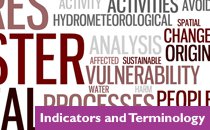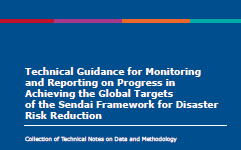- UNISDR
- DesInventar Sendai


The report outlines the OIEWG’s recommended indicators for the seven global targets of the Sendai Framework for Disaster Risk Reduction 2015-2030, the follow-up to and operationalization of the indicators, and recommended terminology relating to disaster risk reduction.

The report outlines the OIEWG’s recommended indicators for the seven global targets of the Sendai Framework for Disaster Risk Reduction 2015-2030, the follow-up to and operationalization of the indicators, and recommended terminology relating to disaster risk reduction.

As the HFA draws to a close, GAR15 questions whether the way in which disaster risk governance has been approached under the HFA is really fit for purpose in a world threatened by catastrophic increases in disaster risk. In GAR15, new evidence on contemporary patterns and trends in disaster risk will be presented to assess to what extent the Expected Outcome of the HFA has been achieved or not. GAR15 also examines whether the way in which disaster risk governance has evolved is appropriate to address increasingly accelerated generation and accumulation of disaster risks. The conclusion will show how disaster risk management can contribute to the transformation of the underlying drivers of risk, and why a reform of disaster risk governance is necessary.

El Informe complementa (para América Latina y el Caribe), los resultados del “Informe de evaluación global sobre la reducción del riesgo de desastres – GAR 2013“, de la UNISDR (Ginebra, mayo de 2013) y acoge los umbrales establecidos en el GAR 2011 para esta región: riesgo extensivo se refiere a pérdida de menos de 25 vidas humanas o menos de 300 viviendas destruidas en un municipio o equivalente, asociadas al impacto de un evento a escala local; riesgo intensivo cuando estas superan dichos umbrales.

'From Shared Risk to Shared Value: the Business Case for Disaster Risk Reduction' explores the interactions between business investments and disaster risk. It highlights how disasters are becoming a growing global challenge to business and country competitiveness, sustainability and resilience - and why business will have to play a central role in efforts to reduce disaster risk. The GAR 13 launches in May at the Global Platform.

The 2011 Global Assessment Report on Disaster Risk Reduction - revealing risk, redefining development - contributes to achieving the Hyogo Framework of Action by monitoring risk patterns and progress in disaster risk reduction. Importantly, it also provides guidance and suggestions to governments and non-governmental actors alike, on how they can, together, reduce disaster risks. This landmark publication builds on and moves beyond the analysis provided by the inaugural Report in 2009.

The 2009 Global Assessment Report on Disaster Risk Reduction - risk and poverty in a changing climate - provides hard-hitting evidence to demonstrate how, where and why disaster risk is increasing globally and presents key findings from a global analysis of disaster risk patterns and trends, including where high mortality and economic loss is concentrated.